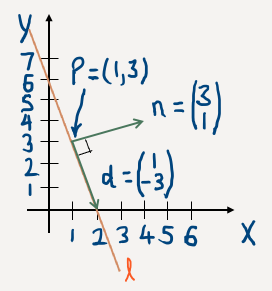Notes
Consider the orange line, l, in the diagram below.

Other features in the diagram are:
- P = (1, 3) is a particular point along the line. In vector form p = (1, 3)T.
- A direction vector for the line, d = (1, –3)T, is shown by the green arrow pointing diagonally down and to the right.
- A normal vector for the line, n = (3, 1)T, is shown by the green arrow pointing diagonally up and to the right. This normal vector is perpendicular to the direction vector.
This line can be represented algebraically in a number of ways:
- The general equation of the line is 3x + y = 6, since it passes through the points (2, 0) and (0, 6).
- The slope-intercept form of the line equation is y = –3x + 6, where the slope is –3 (change in y per unit change in x) and the intercept is 6 (value of y when x = 0).
- The normal form of the line equation is n·x = n·p, which in this case is [latex]\left({3\atop 1}\right)\cdot\left({x\atop y}\right)=\left({3\atop 1}\right)\cdot\left({1\atop 3}\right)[/latex], which is equivalent to 3x + y = 6.
- The vector form of the line equation is x = p +td, where t is a scalar. In this case this form is [latex]\left({x\atop y}\right)=\left({1\atop 3}\right)+t\left({1\atop -3}\right)[/latex].
- Expressing each component of the vector form gives the parametric equations of the line: x = 1 + t and y = 3 – 3t.
Video Tips
Practice Exercises
For each of the following problems drag the numerical quantities into the correct boxes (note that for each problem some quantities don’t belong anywhere). Assume that all vectors are column vectors.

